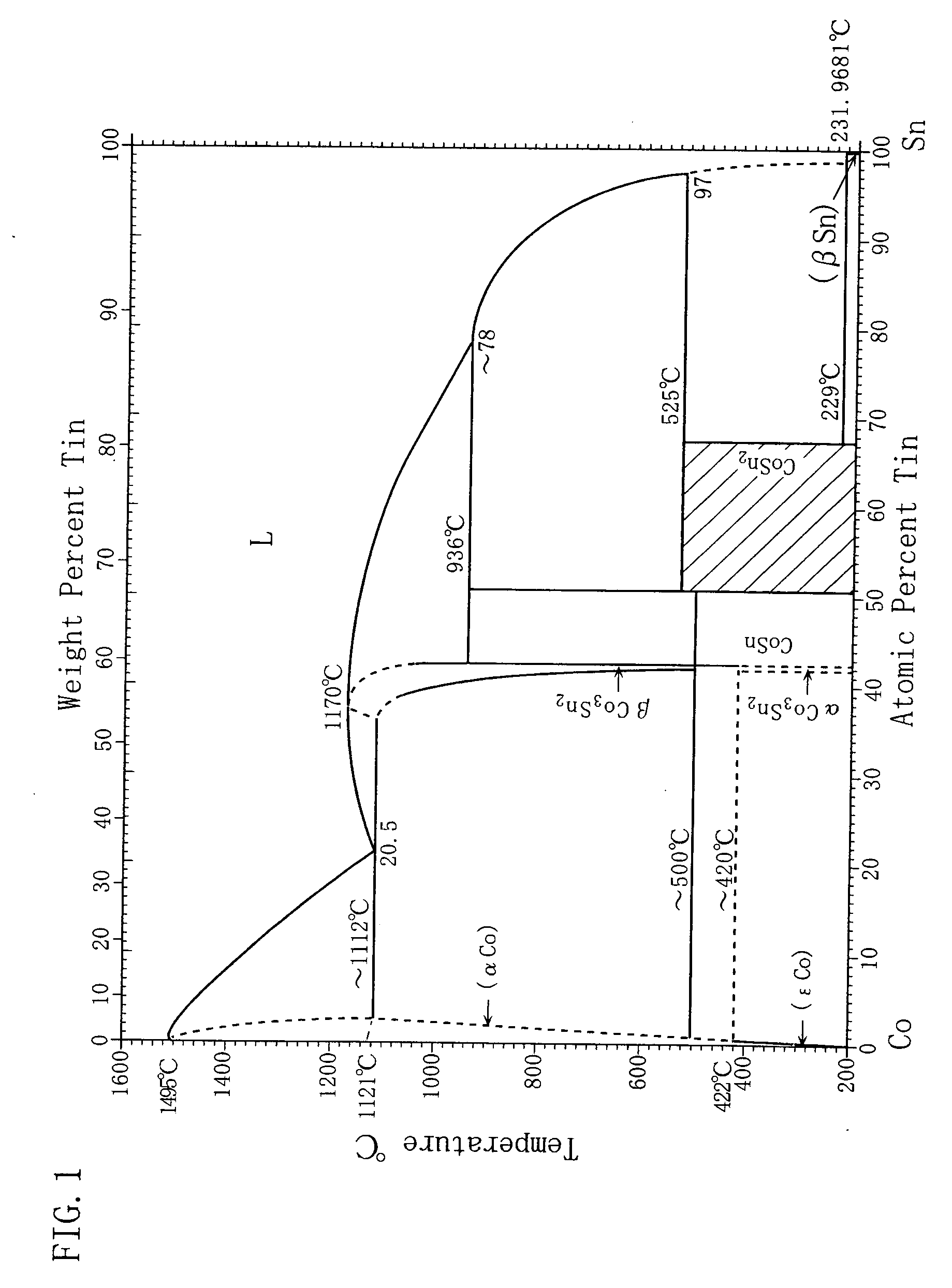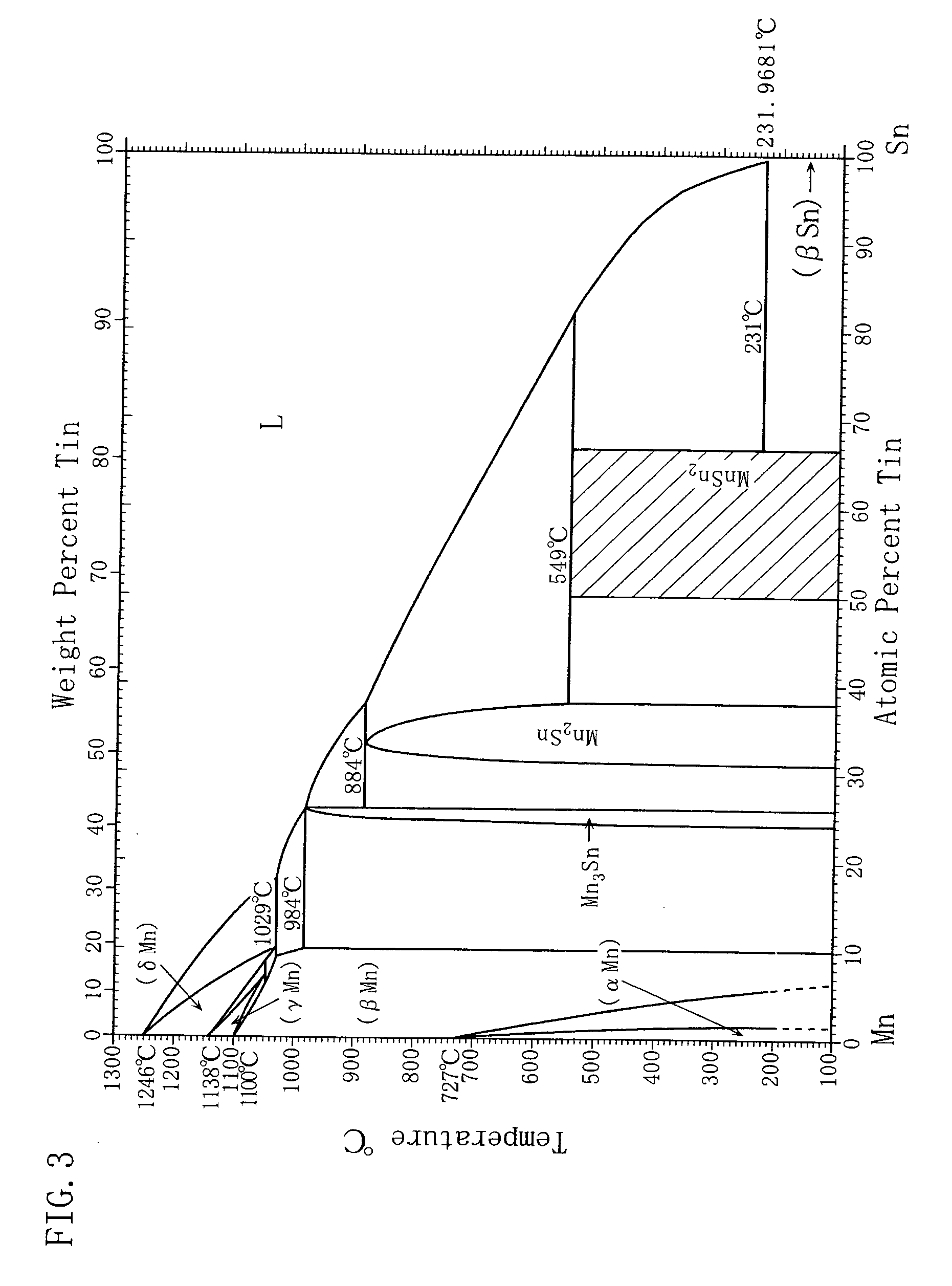Lithium secondary battery, negative electrode therefor, and method of their manufacture
a secondary battery and negative electrode technology, applied in cell components, electrochemical generators, transportation and packaging, etc., can solve the problems of poor discharge capacity, poor charge-discharge cycle performance, and component in the negative electrode mixture layer increases, so as to achieve good discharge capacity, less electrical resistance, and good charge-discharge cycle performance
- Summary
- Abstract
- Description
- Claims
- Application Information
AI Technical Summary
Benefits of technology
Problems solved by technology
Method used
Image
Examples
example 1
Preparation of Negative Electrode
[0050] A particulate negative electrode active material containing the CoSn phase and the CoSn2 phase at a molar ratio of 1:1 (average particle size: 10 μm) were mixed into an N-methyl-2-pyrrolidone solution in which PVdF was dissolved at 8 mass %, to thus prepare a negative electrode mixture slurry. The solid mass ratio of the particulate negative electrode active material to the PVdF in the negative electrode mixture slurry was adjusted to be 93:7 (solid volume ratio: 75:25).
[0051] The resultant negative electrode mixture slurry was applied onto one side (the roughened surface side) of an electrolytic copper foil (thickness: 35 μm) having a surface roughness Ra of 1.0 μm and serving as a negative electrode current collector, and thereafter the negative electrode mixture slurry was dried. The resultant layered material was cut out into dimensions of 20 mm×20 mm and then pressure-rolled. Thereafter, the resultant material was heated (heat-treated)...
example2
[0056] A negative electrode and a battery were fabricated in the same manner as in Example 1 above, except that powder (average particle size: 10 μm) composed only of the Co2—Sn phase was used as the particulate negative electrode active material.
[0057] The negative electrode and the battery thus prepared are hereinafter referred to as a negative electrode a2 of the invention and Battery A2 of the invention.
experiment 1
[0066] A charge-discharge test was conducted under the charge-discharge test conditions set out below, to determine initial charge capacity per unit mass of negative electrode active material (hereafter also simply referred to as “initial charge capacity”) and discharge capacity retention ratio after 5 cycles (hereafter also simply referred to as “discharge capacity retention ratio”) for the foregoing batteries. The results are shown in Table 2 below. It should be noted that the discharge capacity retention ratio after 5 cycles means the ratio of discharge capacity after 5 cycles to initial discharge capacity as defined by the following equation (1).
Discharge capacity retention ratio after 5 cycles=Discharge capacity after 5 cycles / Initial discharge capacity×100 Eq. (1)
Charge-discharge Test Conditions
[0067] Conditions of charge (lithium insertion to negative electrode)
[0068] The batteries were charged at a constant current of 0.1 mA / cm2 to an end-of-charge voltage of 0.0 V (vs. ...
PUM
| Property | Measurement | Unit |
|---|---|---|
| surface roughness Ra | aaaaa | aaaaa |
| mass % | aaaaa | aaaaa |
| particle size | aaaaa | aaaaa |
Abstract
Description
Claims
Application Information
 Login to View More
Login to View More - R&D
- Intellectual Property
- Life Sciences
- Materials
- Tech Scout
- Unparalleled Data Quality
- Higher Quality Content
- 60% Fewer Hallucinations
Browse by: Latest US Patents, China's latest patents, Technical Efficacy Thesaurus, Application Domain, Technology Topic, Popular Technical Reports.
© 2025 PatSnap. All rights reserved.Legal|Privacy policy|Modern Slavery Act Transparency Statement|Sitemap|About US| Contact US: help@patsnap.com



